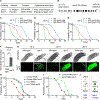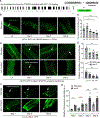LPD-3 as a megaprotein brake for aging and insulin-mTOR signaling in C. elegans
- PMID: 38446666
- PMCID: PMC11019932
- DOI: 10.1016/j.celrep.2024.113899
LPD-3 as a megaprotein brake for aging and insulin-mTOR signaling in C. elegans
Abstract
Insulin-mechanistic target of rapamycin (mTOR) signaling drives anabolic growth during organismal development; its late-life dysregulation contributes to aging and limits lifespans. Age-related regulatory mechanisms and functional consequences of insulin-mTOR remain incompletely understood. Here, we identify LPD-3 as a megaprotein that orchestrates the tempo of insulin-mTOR signaling during C. elegans aging. We find that an agonist insulin, INS-7, is drastically overproduced from early life and shortens lifespan in lpd-3 mutants. LPD-3 forms a bridge-like tunnel megaprotein to facilitate non-vesicular cellular lipid trafficking. Lipidomic profiling reveals increased hexaceramide species in lpd-3 mutants, accompanied by up-regulation of hexaceramide biosynthetic enzymes, including HYL-1. Reducing the abundance of HYL-1, insulin receptor/DAF-2 or mTOR/LET-363, normalizes INS-7 levels and rescues the lifespan of lpd-3 mutants. LPD-3 antagonizes SINH-1, a key mTORC2 component, and decreases expression with age. We propose that LPD-3 acts as a megaprotein brake for organismal aging and that its age-dependent decline restricts lifespan through the sphingolipid-hexaceramide and insulin-mTOR pathways.
Keywords: CP: Metabolism; CP: Molecular biology; Caenorhabditis elegans; IIS-mTOR; INS-7; LPD-3; aging; hexaceramide; hyperfunction; mitochondrial pathway; molecular damages; sphingolipid.
Copyright © 2024 The Author(s). Published by Elsevier Inc. All rights reserved.
Conflict of interest statement
Declaration of interests The authors declare no competing interests.
Figures




Update of
-
LPD-3 as a megaprotein brake for aging and insulin-mTOR signaling in C. elegans.bioRxiv [Preprint]. 2023 Jul 17:2023.02.14.528431. doi: 10.1101/2023.02.14.528431. bioRxiv. 2023. Update in: Cell Rep. 2024 Mar 26;43(3):113899. doi: 10.1016/j.celrep.2024.113899. PMID: 36824874 Free PMC article. Updated. Preprint.
References
MeSH terms
Substances
Grants and funding
LinkOut - more resources
Full Text Sources
Miscellaneous

